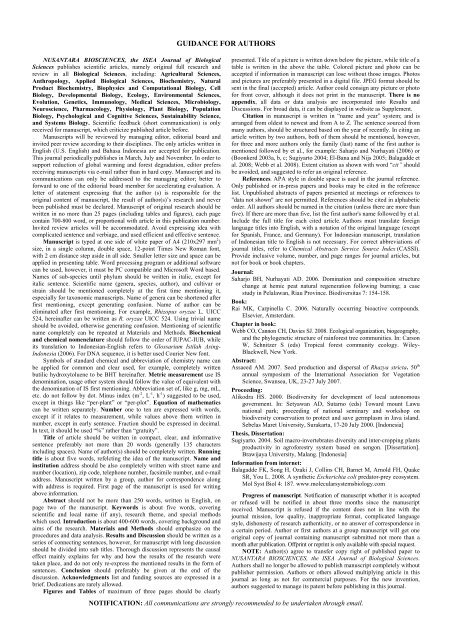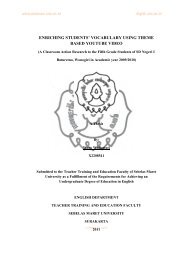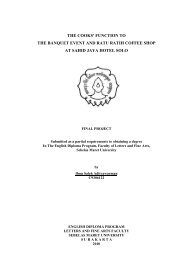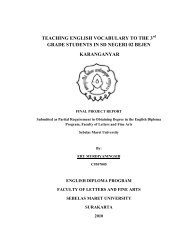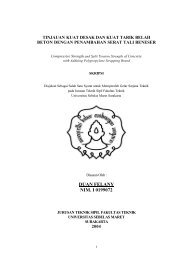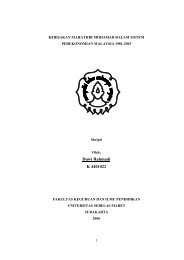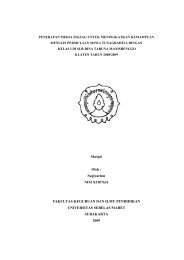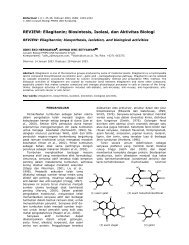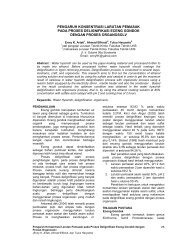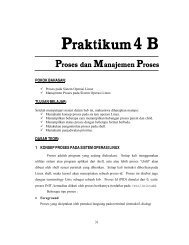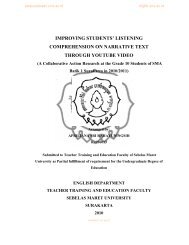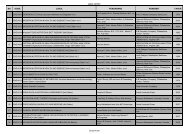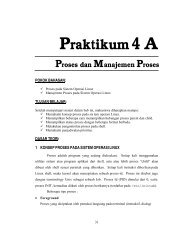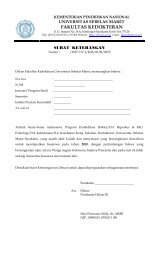ISSN 2087-3940 (PRINT) | ISSN 2087-3956 ... - Biodiversitas
ISSN 2087-3940 (PRINT) | ISSN 2087-3956 ... - Biodiversitas
ISSN 2087-3940 (PRINT) | ISSN 2087-3956 ... - Biodiversitas
Create successful ePaper yourself
Turn your PDF publications into a flip-book with our unique Google optimized e-Paper software.
GUIDANCE FOR AUTHORS<br />
NUSANTARA BIOSCIENCES, the ISEA Journal of Biological<br />
Sciences publishes scientific articles, namely original full research and<br />
review in all Biological Sciences, including: Agricultural Sciences,<br />
Anthropology, Applied Biological Sciences, Biochemistry, Natural<br />
Product Biochemistry, Biophysics and Computational Biology, Cell<br />
Biology, Developmental Biology, Ecology, Environmental Sciences,<br />
Evolution, Genetics, Immunology, Medical Sciences, Microbiology,<br />
Neuroscience, Pharmacology, Physiology, Plant Biology, Population<br />
Biology, Psychological and Cognitive Sciences, Sustainability Science,<br />
and Systems Biology. Scientific feedback (short communication) is only<br />
received for manuscript, which criticize published article before.<br />
Manuscripts will be reviewed by managing editor, editorial board and<br />
invited peer review according to their disciplines. The only articles written in<br />
English (U.S. English) and Bahasa Indonesia are accepted for publication.<br />
This journal periodically publishes in March, July and November. In order to<br />
support reduction of global warming and forest degradation, editor prefers<br />
receiving manuscripts via e-mail rather than in hard copy. Manuscript and its<br />
communications can only be addressed to the managing editor; better to<br />
forward to one of the editorial board member for accelerating evaluation. A<br />
letter of statement expressing that the author (s) is responsible for the<br />
original content of manuscript, the result of author(s)’s research and never<br />
been published must be declared. Manuscript of original research should be<br />
written in no more than 25 pages (including tables and figures), each page<br />
contain 700-800 word, or proportional with article in this publication number.<br />
Invited review articles will be accommodated. Avoid expressing idea with<br />
complicated sentence and verbiage, and used efficient and effective sentence.<br />
Manuscript is typed at one side of white paper of A4 (210x297 mm 2 )<br />
size, in a single column, double space, 12-point Times New Roman font,<br />
with 2 cm distance step aside in all side. Smaller letter size and space can be<br />
applied in presenting table. Word processing program or additional software<br />
can be used, however, it must be PC compatible and Microsoft Word based.<br />
Names of sub-species until phylum should be written in italic, except for<br />
italic sentence. Scientific name (genera, species, author), and cultivar or<br />
strain should be mentioned completely at the first time mentioning it,<br />
especially for taxonomic manuscripts. Name of genera can be shortened after<br />
first mentioning, except generating confusion. Name of author can be<br />
eliminated after first mentioning. For example, Rhizopus oryzae L. UICC<br />
524, hereinafter can be written as R. oryzae UICC 524. Using trivial name<br />
should be avoided, otherwise generating confusion. Mentioning of scientific<br />
name completely can be repeated at Materials and Methods. Biochemical<br />
and chemical nomenclature should follow the order of IUPAC-IUB, while<br />
its translation to Indonesian-English refers to Glossarium Istilah Asing-<br />
Indonesia (2006). For DNA sequence, it is better used Courier New font.<br />
Symbols of standard chemical and abbreviation of chemistry name can<br />
be applied for common and clear used, for example, completely written<br />
butilic hydroxytoluene to be BHT hereinafter. Metric measurement use IS<br />
denomination, usage other system should follow the value of equivalent with<br />
the denomination of IS first mentioning. Abbreviation set of, like g, mg, mL,<br />
etc. do not follow by dot. Minus index (m -2 , L -1 , h -1 ) suggested to be used,<br />
except in things like “per-plant” or “per-plot”. Equation of mathematics<br />
can be written separately. Number one to ten are expressed with words,<br />
except if it relates to measurement, while values above them written in<br />
number, except in early sentence. Fraction should be expressed in decimal.<br />
In text, it should be used “%” rather than “gratuity”.<br />
Title of article should be written in compact, clear, and informative<br />
sentence preferably not more than 20 words (generally 135 characters<br />
including spaces). Name of author(s) should be completely written. Running<br />
title is about five words, refelcting the idea of the manuscript. Name and<br />
institution address should be also completely written with street name and<br />
number (location), zip code, telephone number, facsimile number, and e-mail<br />
address. Manuscript written by a group, author for correspondence along<br />
with address is required. First page of the manuscript is used for writing<br />
above information.<br />
Abstract should not be more than 250 words, written in English, on<br />
page two of the manuscript. Keywords is about five words, covering<br />
scientific and local name (if any), research theme, and special methods<br />
which used. Introduction is about 400-600 words, covering background and<br />
aims of the research. Materials and Methods should emphasize on the<br />
procedures and data analysis. Results and Discussion should be written as a<br />
series of connecting sentences, however, for manuscript with long discussion<br />
should be divided into sub titles. Thorough discussion represents the causal<br />
effect mainly explains for why and how the results of the research were<br />
taken place, and do not only re-express the mentioned results in the form of<br />
sentences. Conclusion should preferably be given at the end of the<br />
discussion. Acknowledgments list and funding sources are expressed in a<br />
brief. Dedications are rarely allowed.<br />
Figures and Tables of maximum of three pages should be clearly<br />
presented. Title of a picture is written down below the picture, while title of a<br />
table is written in the above the table. Colored picture and photo can be<br />
accepted if information in manuscript can lose without those images. Photos<br />
and pictures are preferably presented in a digital file. JPEG format should be<br />
sent in the final (accepted) article. Author could consign any picture or photo<br />
for front cover, although it does not print in the manuscript. There is no<br />
appendix, all data or data analysis are incorporated into Results and<br />
Discussions. For broad data, it can be displayed in website as Supplement.<br />
Citation in manuscript is written in “name and year” system; and is<br />
arranged from oldest to newest and from A to Z. The sentence sourced from<br />
many authors, should be structured based on the year of recently. In citing an<br />
article written by two authors, both of them should be mentioned, however,<br />
for three and more authors only the family (last) name of the first author is<br />
mentioned followed by et al., for example: Saharjo and Nurhayati (2006) or<br />
(Boonkerd 2003a, b, c; Sugiyarto 2004; El-Bana and Nijs 2005; Balagadde et<br />
al. 2008; Webb et al. 2008). Extent citation as shown with word “cit” should<br />
be avoided, and suggested to refer an original reference.<br />
References. APA style in double space is used in the journal reference.<br />
Only published or in-press papers and books may be cited in the reference<br />
list. Unpublished abstracts of papers presented at meetings or references to<br />
"data not shown" are not permitted. References should be cited in alphabetic<br />
order. All authors should be named in the citation (unless there are more than<br />
five). If there are more than five, list the first author's name followed by et al.<br />
Include the full title for each cited article. Authors must translate foreign<br />
language titles into English, with a notation of the original language (except<br />
for Spanish, France, and Germany). For Indonesian manuscript, translation<br />
of Indonesian title to English is not necessary. For correct abbreviations of<br />
journal titles, refer to Chemical Abstracts Service Source Index (CASSI).<br />
Provide inclusive volume, number, and page ranges for journal articles, but<br />
not for book or book chapters.<br />
Journal:<br />
Saharjo BH, Nurhayati AD. 2006. Domination and composition structure<br />
change at hemic peat natural regeneration following burning; a case<br />
study in Pelalawan, Riau Province. <strong>Biodiversitas</strong> 7: 154-158.<br />
Book:<br />
Rai MK, Carpinella C. 2006. Naturally occurring bioactive compounds.<br />
Elsevier, Amsterdam.<br />
Chapter in book:<br />
Webb CO, Cannon CH, Davies SJ. 2008. Ecological organization, biogeography,<br />
and the phylogenetic structure of rainforest tree communities. In: Carson<br />
W, Schnitzer S (eds) Tropical forest community ecology. Wiley-<br />
Blackwell, New York.<br />
Abstract:<br />
Assaeed AM. 2007. Seed production and dispersal of Rhazya stricta. 50 th<br />
annual symposium of the International Association for Vegetation<br />
Science, Swansea, UK, 23-27 July 2007.<br />
Proceeding:<br />
Alikodra HS. 2000. Biodiversity for development of local autonomous<br />
government. In: Setyawan AD, Sutarno (eds) Toward mount Lawu<br />
national park; proceeding of national seminary and workshop on<br />
biodiversity conservation to protect and save germplasm in Java island.<br />
Sebelas Maret University, Surakarta, 17-20 July 2000. [Indonesia]<br />
Thesis, Dissertation:<br />
Sugiyarto. 2004. Soil macro-invertebrates diversity and inter-cropping plants<br />
productivity in agroforestry system based on sengon. [Dissertation].<br />
Brawijaya University, Malang. [Indonesia]<br />
Information from internet:<br />
Balagadde FK, Song H, Ozaki J, Collins CH, Barnet M, Arnold FH, Quake<br />
SR, You L. 2008. A synthetic Escherichia coli predator-prey ecosystem.<br />
Mol Syst Biol 4: 187. www.molecularsystemsbiology.com<br />
Progress of manuscript. Notification of manuscript whether it is accepted<br />
or refused will be notified in about three months since the manuscript<br />
received. Manuscript is refused if the content does not in line with the<br />
journal mission, low quality, inappropriate format, complicated language<br />
style, dishonesty of research authenticity, or no answer of correspondence in<br />
a certain period. Author or first authors at a group manuscript will get one<br />
original copy of journal containing manuscript submitted not more than a<br />
month after publication. Offprint or reprint is only available with special request.<br />
NOTE: Author(s) agree to transfer copy right of published paper to<br />
NUSANTARA BIOSCIENCES, the ISEA Journal of Biological Sciences.<br />
Authors shall no longer be allowed to publish manuscript completely without<br />
publisher permission. Authors or others allowed multiplying article in this<br />
journal as long as not for commercial purposes. For the new invention,<br />
authors suggested to manage its patent before publishing in this journal.<br />
NOTIFICATION: All communications are strongly recommended to be undertaken through email.


